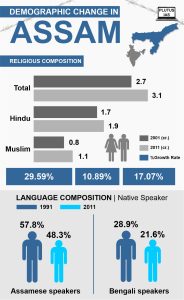09 Dec Supreme Court’s Inquiry into Illegal Immigration
This article covers “Daily Current Affairs” and the topic details “ Supreme Court’s Inquiry into Illegal Immigration”. This topic has relevance in the Polity and Governance section of the UPSC CSE exam.
GS 2: Polity and Governance
Why in the news?
Recently, a Constitution bench consisting of five judges in the Supreme Court commenced the hearing of petitions that challenge Section 6A of the Citizenship Act, 1955. This provision was incorporated into the statute subsequent to the endorsement of the Assam Accord.
Background:
A five-judge bench of the Supreme Court recently addressed concerns about the impact of an “unlimited influx” of illegal migrants from Bangladesh on demographics and resources allocated for Indian citizens. The court, during the hearing of related petitions, questioned the applicability of Section 6A, granting Indian citizenship benefits to illegal migrants, solely in Assam and not in West Bengal, which shares a larger portion of the Bangladesh border.
Supreme Court’s Directives:
- The court directed the Home Secretary to submit an affidavit by May 11, 2023, detailing the estimated inflow of illegal migrants into India, especially in Assam, post-March 25, 1971.
- The affidavit is expected to outline the measures taken by the Centre to address illegal immigration and provide specifics on the extent and timelines for border-fencing.
- The government is instructed to furnish details regarding illegal immigration along the West Bengal border after March 25, 1971.
Central Government’s Defense:
- The central government refutes claims of unfairly burdening Assam with illegal migrants, contending that different states can be classified differently based on historical and geographical grounds.
- Arguing against allegations of arbitrariness, the Centre asserts that Article 14’s guarantee against non-arbitrariness does not mandate universal application of laws, emphasizing the need for differentiation based on dissimilarity or the nature of individuals concerned.
Assam Accord:
The Assam Accord emerged as a Memorandum of Settlement (MoS) following the Assam Movement (1979–1985), a significant uprising in the state. The movement aimed to address the issue of illegal immigrants, primarily Bangladeshi, and sought the detection, disenfranchisement, and deportation of such individuals.
Terms of the Assam Accord:
Border Security Measures:
- The Accord mandated the erection of physical barriers, like walls and barbed wire fencing, along the Bangladesh-India border.
- Security forces were deployed for land and river patrols to prevent infiltration.
Classification of Immigrants:
- Immigrants who entered Assam before January 1, 1966, were considered Indian citizens and allowed to vote.
- Those entering between January 1, 1966, and March 24, 1971, were granted Indian citizenship but prohibited from voting for the first 10 years.
- Immigrants arriving on or after March 25, 1971, were classified as illegal and subjected to expulsion.
Political Impact:
- The Accord led to the conclusion of the Assam Movement and enabled leaders of the agitation to form a political party and establish a government in Assam.

Introduction of Section 6A:
- Section 6A of the Citizenship Act, 1955, was introduced to implement the provisions of the Assam Accord.
Challenges to Section 6A:
- Supreme Court Proceedings: The Supreme Court is currently hearing petitions challenging the constitutional validity of Section 6A.
- Concerns Raised by Indigenous Groups: Indigenous Assamese groups argue that Section 6A acts as a lure for illegal migrants to settle in Assam, gaining Indian citizenship.
- Alleged Violation of Rights: Petitioners claim that the special provision is arbitrary, singles out Assam, violates Article 14, and contributes to an influx of illegal migrants from Bangladesh.
- Proposed Cut-off Date: Petitioners, led by the Assam Sanmilita Mahasangha (ASM), advocate for establishing 1951 as the cut-off date for inclusion in the National Register of Citizens instead of 1971.
- Discriminatory Nature: The core argument is that Section 6A, with its different cut-off date for Indian citizenship in Assam, is discriminatory, arbitrary, and violates the rights of indigenous Assamese people.
SOURCE: Supreme Court asks Centre to furnish illegal immigrant details – The Economic Times (indiatimes.com)
Download plutus ias current affairs eng med 9th Dec 2023
Q.1 With reference to the Assam Accord, consider the following statements:
- The Assam Accord resulted from the Assam Movement (1979–1985), addressing the issue of illegal immigrants, primarily from Bangladesh.
- The Accord mandated the erection of physical barriers, such as walls and barbed wire fencing, along the Bangladesh-India border for enhanced security.
- Immigrants who entered Assam before January 1, 1966, were considered Indian citizens and allowed to vote.
Which of the statements given above is/are correct?
(a) 1 and 2 only
(b) 2 and 3 only
(c) 1, 2 and 3
(d) 1 and 3 only
ANSWER: C
Q.2 Discuss the multifaceted challenges posed by illegal migration in India, considering its socio-economic, political, and cultural implications.



No Comments